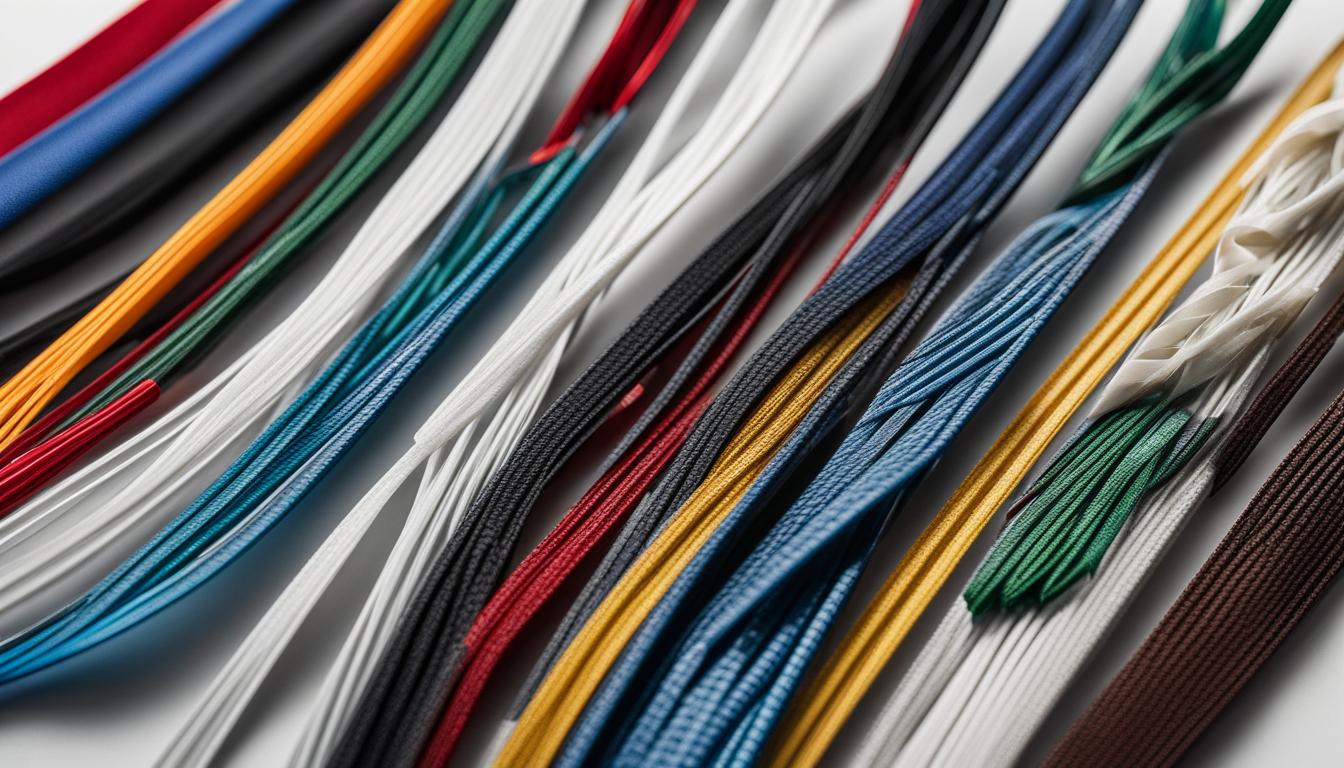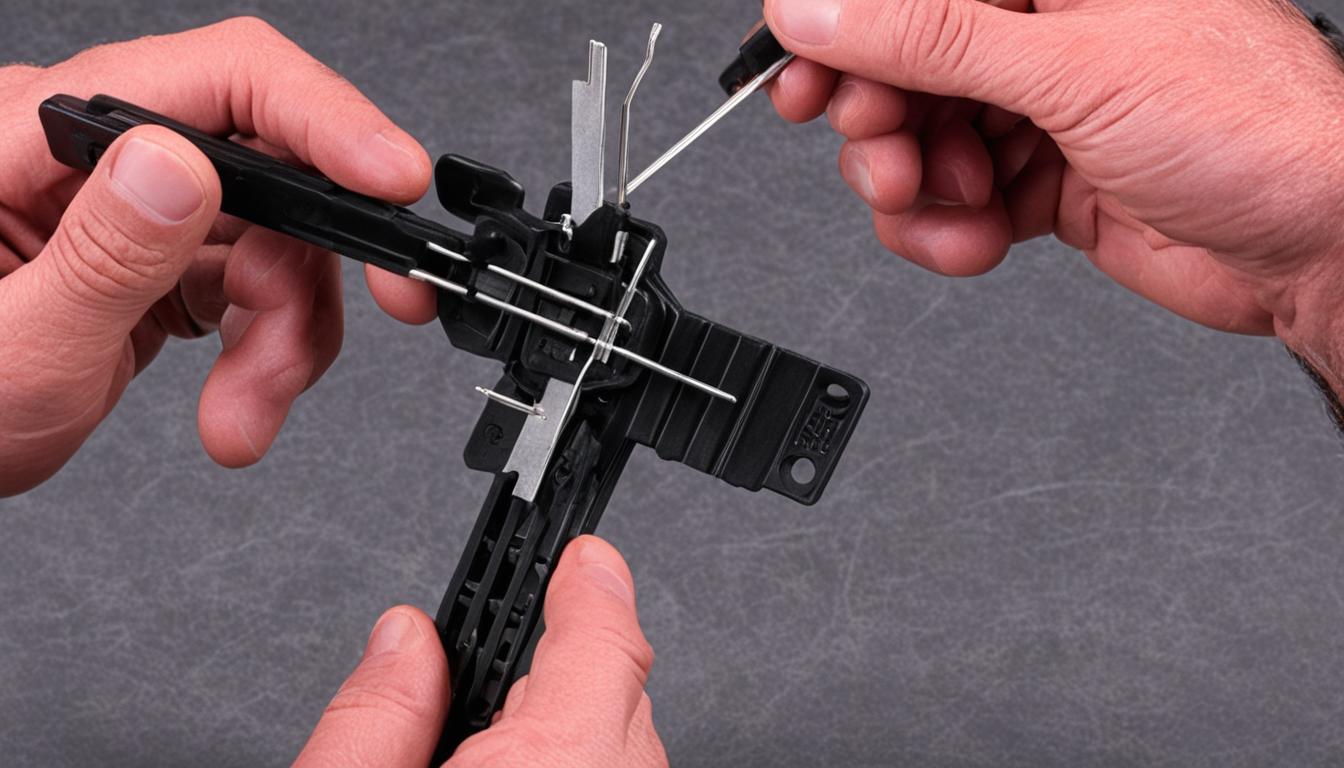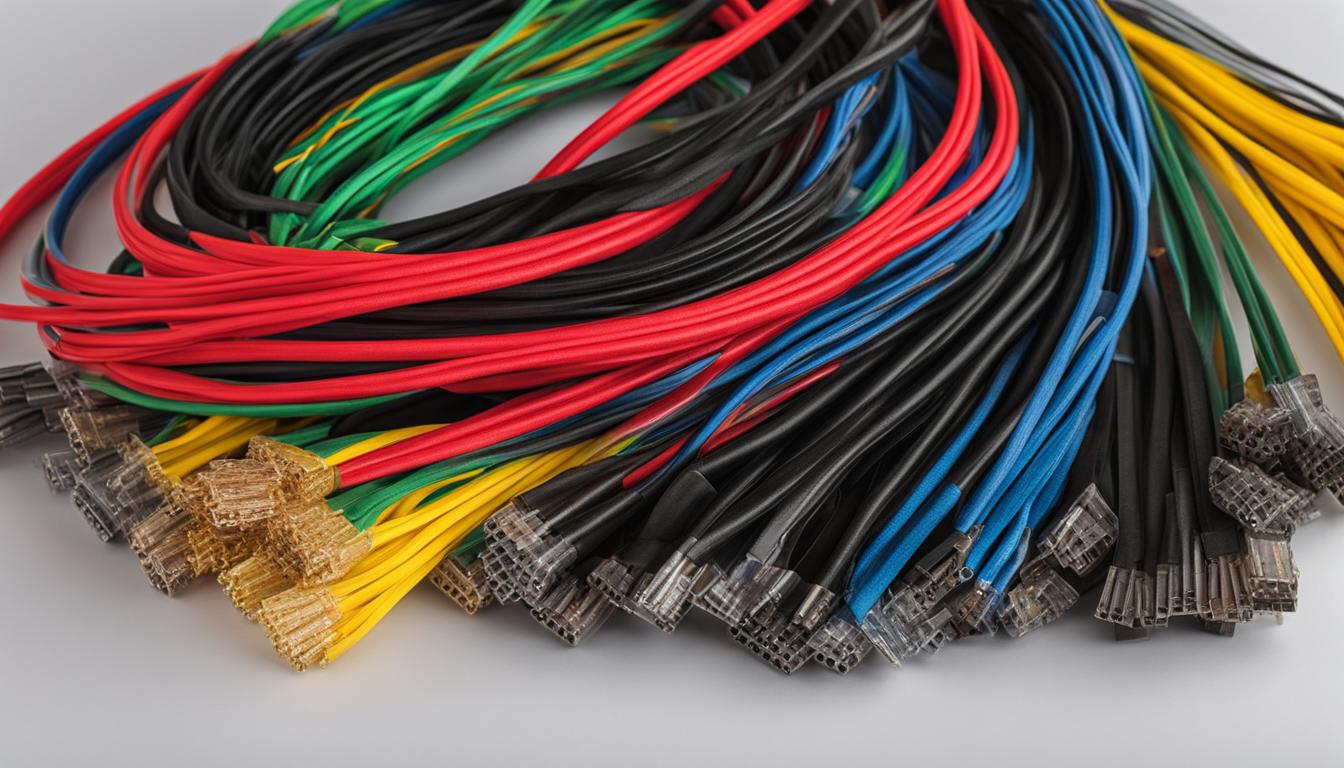
In this article, I will guide you through the world of zip ties and help you understand the different types available. Whether you call them zip ties, cable ties, or nylon ties, these versatile fasteners have a wide range of applications in various industries and settings.
Zip ties are used for bundling cables and wires together, providing organization and preventing damage. They come in different materials, sizes, and strengths to suit different needs. From lightweight plastic ties to heavy-duty options, there is a zip tie for every job.
So, let’s dive in and explore the different types of zip ties, their materials, and their various applications. By the end of this article, you’ll have a better understanding of which zip tie is the right fit for your specific needs.
Key Takeaways:
- Zip ties, also known as cable ties, are used for bundling cables and wires together.
- There are different types of zip ties available, ranging from lightweight plastic ties to heavy-duty options.
- The materials used for zip ties include nylon, plastic, and even stainless steel.
- Zip ties find applications in various industries, such as automotive, electronics, and construction.
- When choosing a zip tie, consider factors such as the environment, temperature, and strength requirements.
What are Cable Ties Used for?
Cable ties, also known as zip ties, are versatile fasteners used to bundle and secure cables and wires together. They play a crucial role in organizing cables and preventing damage from tangles and tripping hazards. With their simple yet efficient design, cable ties have become indispensable in various industries and settings.
Here are some key features and applications of cable ties:
- Size, Length, and Material: Cable ties come in different sizes and lengths to accommodate various cable diameters. They are made from durable materials such as nylon, which offers excellent strength and resistance to environmental factors.
- Color Options: Cable ties are available in a wide range of colors, allowing for easy color-coding and identification of cables in complex systems.
- Versatility: Cable ties can be used in a wide range of industries, including automotive, electronics, construction, and more. They are suitable for both indoor and outdoor applications.
Here is an example of how cable ties can be used in practice:
I work in the electronics industry, where cable management is critical. We use cable ties to organize and secure the various cables inside our electronic devices. Whether it’s bundling wires together or securing them to the chassis, cable ties provide a neat and organized solution. They save us a tremendous amount of time during assembly and troubleshooting, and they ensure that our products are reliable and visually appealing.
With their reliability, affordability, and ease of use, cable ties have emerged as the go-to option for managing cable systems. Whether you’re a professional in the industry or a DIY enthusiast, cable ties are an essential tool to keep your cables organized and protected.
Stay tuned for the next section, where we’ll dive deeper into the fascinating history of cable ties and the inventor behind this groundbreaking invention.
The History of Cable Ties
Cable ties, also known as zip ties, have become indispensable tools in cable management and organization. But have you ever wondered about their origin? Let’s take a journey back in time to discover the fascinating history behind cable ties.
In 1958, Maurus C. Logan, a Scottish-born engineer working at Thomas & Betts, revolutionized the way cables were secured. During a visit to an aircraft facility, Logan observed the labor-intensive and time-consuming process of manually securing cables with knotted, braided nylon cords.
Inspired by these observations, Logan set out to create an innovative solution that would simplify cable management. Drawing on his engineering expertise, he conceived the idea of the cable tie. This ingenious invention would replace the cumbersome cords with a single, easy-to-use fastening device.
Logan’s invention quickly gained recognition for its efficiency and versatility. Cable ties provided a quick and reliable method for securing cables, reducing installation time and enhancing safety. As word spread about the convenience and effectiveness of cable ties, their popularity skyrocketed.
Today, cable ties are utilized in a wide range of industries and applications, from electronics and automotive manufacturing to construction and mining. The invention of cable ties by Maurus C. Logan has transformed cable management practices and continues to impact various sectors.
Let’s take a moment to appreciate the ingenuity and foresight of the inventor of cable ties, Maurus C. Logan, whose innovative solution continues to simplify our lives.

Key Points:
- Cable ties, or zip ties, were invented by Maurus C. Logan, an engineer who worked at Thomas & Betts.
- Logan came up with the idea in 1958 after observing the labor-intensive process of manually securing cables with braided nylon cords.
- The invention of cable ties revolutionized cable management, offering a quicker and more efficient way to secure cables.
- Cable ties were embraced across industries due to their effectiveness, versatility, and time-saving benefits.
- Today, cable ties are widely used in various applications, from electronics to construction.
Different Types of Cable Ties
When it comes to cable ties, there is a wide variety of options available to suit different applications and requirements. Understanding the different types can help you choose the right cable tie for your needs.
Nylon Zip Ties: Nylon zip ties are the most common and versatile type of cable tie. They are durable, affordable, and come in various lengths and strengths. Nylon zip ties are suitable for a wide range of applications and are widely used in industries such as electronics, automotive, and construction.
Heat-Stabilized Cable Ties: Heat-stabilized cable ties are designed to withstand high temperatures without losing their strength or integrity. They are often used in industrial applications where exposure to heat is a concern, such as in automotive engines or machinery.
Mounting Cable Ties: Mounting cable ties have a built-in mount that allows them to be easily attached to surfaces, such as walls or panels. They are commonly used for organizing cables in cabinets, electrical enclosures, or other fixed structures.
Belt Cable Ties: Belt cable ties are heavy-duty ties that are used for securing heavy bundles or objects. They have a wider and stronger design compared to standard zip ties, making them ideal for applications that require extra strength and security.
Releasable Cable Ties: Releasable cable ties are designed for applications where the cables or wires may need to be removed or repositioned frequently. They feature a mechanism that allows for easy release and reusability, making them a more convenient option for certain installations.
Push Mount Cable Ties: Push mount cable ties are equipped with a push mount base that can be secured to surfaces without the need for additional hardware. They are commonly used for organizing cables or wires in tight spaces or areas where drilling or mounting is not feasible.
Screw Mount Cable Ties: Screw mount cable ties have a self-tapping screw that allows them to be securely fastened to surfaces. They are suitable for applications that require a more permanent and sturdy attachment.
Marker Cable Ties: Marker cable ties have a label area that allows for easy identification and labeling of cables or wires. They are useful for organizing and managing large cable bundles or in situations where clear labeling is necessary.
Stainless Steel Cable Ties: Stainless steel cable ties are extremely durable, resistant to corrosion, and able to withstand harsh environments. They are commonly used in industries such as marine, aerospace, or oil and gas, where high strength and resistance to extreme conditions are essential.
Heavy-Duty Strap and Buckle: Heavy-duty strap and buckle cable ties are designed for heavy-duty applications where a high tensile strength and secure fastening are required. They are commonly used in construction, mining, or industrial settings.
Double Headed Cable Ties: Double-headed cable ties have two locking heads, allowing for a stronger and more secure fastening. They are suitable for applications that require extra strength, such as securing heavy cables or bundling large objects.
Adjustable Cable Straps: Adjustable cable straps offer flexibility in terms of length adjustment, making them suitable for various cable management needs. They are commonly used in situations where cables or wires may need to be added or removed frequently.
By understanding the different types of cable ties available, you can select the most suitable option for your specific application and ensure efficient and organized cable management.
Common Materials for Cable Ties
When it comes to cable ties, it’s important to understand the different materials used in their construction. Each material offers specific properties and benefits that make it suitable for various applications. Let’s take a closer look at some common cable tie materials:
Nylon Cable Ties
One of the most widely used materials for cable ties is nylon. Nylon cable ties are known for their high-strength build, thermal resistance, and abrasion resistance. These ties can withstand challenging environments and are often used in industries that require durable and reliable cable management solutions.
Polypropylene Cable Ties
Polypropylene (PE) is another common material used for cable ties. These ties offer excellent chemical resistance, making them ideal for use in environments where exposure to hazardous substances is a concern. Polypropylene cable ties are also known for their lightweight and cost-effective nature.
Low Density Polyethylene Cable Ties
Low-density polyethylene (LDPE) cable ties are frequently used in temporary bundling applications. Their flexibility and ease of use make them suitable for situations where cables need to be bundled and secured temporarily. LDPE cable ties are versatile and can be quickly and effortlessly adjusted or removed as needed.
Stainless Steel Cable Ties
For demanding applications that require exceptional strength, resistance to extreme temperatures, and superior durability, stainless steel cable ties are the go-to choice. These ties are particularly well-suited for industries such as construction, mining, and marine where reliability and longevity are paramount.
Understanding the different materials used in cable ties allows you to choose the most appropriate type for your specific requirements. Whether you need high-strength nylon ties or chemical-resistant polypropylene ties, selecting the right material ensures efficient and dependable cable management.

| Material | Properties | Benefits |
|---|---|---|
| Nylon | High-strength, thermal resistance, abrasion resistance | Durable, reliable, ideal for challenging environments |
| Polypropylene (PE) | Chemical resistance, lightweight | Cost-effective, suitable for hazardous environments |
| Low-Density Polyethylene (LDPE) | Flexibility, temporary bundling | Versatile, quick adjustment and removal |
| Stainless Steel | High strength, extreme temperature resistance, durability | Reliable, long-lasting, ideal for demanding applications |
Applications of Cable Ties
Cable ties are incredibly versatile fasteners with a wide range of applications across various industries. Let’s explore some of the key industries where cable ties find extensive use:
Automotive
In the automotive industry, cable ties play a crucial role in organizing and securing wiring harnesses. They need to be resistant to chemicals, heat, and vibrations to ensure the safe and stable operation of vehicle systems.
Equipment Manufacturing
In equipment manufacturing, cable ties are frequently employed for bundling and securing vibrating parts. These ties withstand the rigors of heavy machinery and provide crucial support to maintain the integrity of electrical connections.
Consumer Appliances
Cable ties find wide application in consumer appliances and electronics, where they are used for cable management in televisions, computers, kitchen appliances, and more. These ties need to be heat-resistant and space-saving to ensure efficient and organized wiring setups.
Electronics
The electronics industry heavily relies on cable ties to organize and secure cables, ensuring optimal performance and tidy installations. From intricate circuitry in circuit boards to complex setups in server rooms, cable ties play an indispensable role in maintaining order.
Enclosures and Cabinets
In enclosures and cabinets, cable ties are essential for cable management and organization. They keep cables neatly bundled and prevent tangling or damage, facilitating easy access and maintenance.
Construction
In the construction industry, cable ties are used for securing and bundling cables in various applications. Whether it’s wiring for lighting systems, security systems, or data networks, cable ties provide a reliable solution for managing the vast array of cables involved.
Mining
In the mining sector, cable ties are used in demanding and harsh environments. They are essential for securing and bundling cables to withstand extreme temperatures, vibrations, and exposure to chemicals.
These are just a few examples of the wide range of applications for cable ties. Their versatility, reliability, and ease of use make them an indispensable tool in countless industries.
| Industry | Key Applications |
|---|---|
| Automotive | Wiring harnesses, secure cable routing |
| Equipment Manufacturing | Bundling, securing vibrating parts |
| Consumer Appliances | Heat-resistant cable management |
| Electronics | Cable organization, space-saving solutions |
| Enclosures and Cabinets | Cable management, organization |
| Construction | Securing and bundling cables |
| Mining | Cable management in extreme conditions |

How to Remove Zip Ties without Cutting
While most zip ties are designed for single-use, there are reusable zip ties available that can be removed and reused. To remove traditional single-use zip ties without cutting them, you can use a pin or fingernail to release the locking mechanism and slide the tie out. However, it is important to note that reusing single-use zip ties may compromise their effectiveness. Reusable zip ties, also known as releasable zip ties, feature a lever or button that allows for easy release and repositioning of the tie.

Removing Single-Use Zip Ties:
- Locate the locking mechanism – This is the part of the zip tie that secures it in place.
- Insert a pin or fingernail into the locking mechanism – Apply gentle pressure to release the locking mechanism.
- Slide the tie out – Once the lock is released, slide the zip tie out of position.
Benefits of Reusable Zip Ties:
- Easy removal and repositioning – Reusable zip ties typically feature a lever or button that allows for quick release and readjustment.
- Sustainability – By reusing zip ties, you reduce waste and contribute to a more sustainable environment.
- Cost-effective – Investing in reusable zip ties can save you money in the long run compared to constantly purchasing single-use options.
By understanding how to remove zip ties without cutting them and exploring the benefits of reusable zip ties, you can effectively manage and organize your cables while reducing waste.
Cable Tie Alternatives
While cable ties are versatile and efficient, there are alternative options available. One popular alternative is Velcro cable ties, which use a Velcro strap to bundle and secure cables. Velcro cable ties are reusable and provide flexibility in cable organization. They are especially useful in situations where frequent changes or adjustments to cable arrangements are required.
Unlike traditional cable ties that need to be cut and discarded, Velcro cable ties can be easily opened and closed, allowing for easy repositioning and cable management. The Velcro strap offers a strong and secure hold, keeping cables organized and preventing tangling.
Another advantage of Velcro cable ties is their versatility. They come in various sizes and lengths, allowing you to bundle cables of different thicknesses. The adjustable nature of Velcro cable ties makes them suitable for organizing cables in different environments, such as offices, home entertainment systems, or even outdoor activities.
Furthermore, Velcro cable ties are not only limited to cable management. They can be used for securing other items, such as hoses, cords, or even organizing tools and equipment. Their reusable nature makes them a cost-effective solution, saving you money in the long run.

When considering cable tie alternatives, Velcro cable ties offer a practical and efficient solution for your cable management needs. Their flexibility, reusability, and versatility make them a popular choice among professionals and individuals alike.
Choosing the Right Zip Tie for Your Needs
When it comes to selecting the appropriate zip tie for your application, it’s crucial to consider the specific requirements and factors that come into play. By understanding the different types and features of zip ties, you can make an informed decision that ensures optimal performance.
Factors to Consider
- Environment: Evaluate the conditions in which the zip tie will be used. Factors such as moisture, UV exposure, and temperature variations should be taken into account.
- Material Compatibility: Consider the materials of the objects or cables that will be secured with the zip tie. Ensure that the chosen zip tie material is compatible and will not cause damage or degradation.
- Tensile Strength: Determine the required strength of the zip tie. Consider the weight of the bundled cables and the level of tension required to secure them effectively.
- Intended Use: Identify the specific application for which the zip tie will be used. Different types of zip ties are designed for various purposes, such as standard bundling, heavy-duty applications, or even color-coding for organization.
By taking these factors into consideration, you can effectively narrow down your options and choose the most suitable zip tie for your needs.
| Type of Zip Tie | Features |
|---|---|
| Nylon Zip Ties | Durable, versatile, and widely used. Suitable for various applications, including general bundling and organization. |
| Heavy-Duty Zip Ties | Designed to withstand heavy loads and harsh conditions. Ideal for industrial or outdoor applications that require extra strength and durability. |
| Releasable Zip Ties | Allow for easy release and repositioning. Perfect for applications where cables may need to be adjusted or removed frequently. |
| Stainless Steel Zip Ties | Offer exceptional strength and resistance to extreme temperatures and chemical exposure. Commonly used in demanding environments. |
Remember, choosing the right zip tie is essential for ensuring reliable cable management and organization. By considering the factors mentioned above and understanding the features of different zip tie types, you can make an informed decision and select the most suitable option for your needs.
“Choosing the right zip tie for your specific application is crucial to ensure optimal performance and durability.” – [Your Name]
Tips for Properly Using Zip Ties
Proper usage of zip ties is crucial to ensure effective cable management and organization. By following these helpful tips, you can maximize the functionality of your zip ties and avoid potential issues:
Select the Appropriate Size and Strength
When using zip ties, it’s important to choose the right size and strength for your specific application. Consider the diameter of the cables or wires you are bundling and select a zip tie that can comfortably accommodate them. Additionally, assess the weight and tension requirements to determine the appropriate strength of the zip tie. Using zip ties that are too small or weak can result in inadequate cable management or even breakage.
Avoid Over-Tightening
While zip ties are designed to secure cables tightly, it’s crucial to avoid over-tightening them. Pulling the zip tie excessively can cause damage to the cables, leading to insulation breaches or even cable failure. Remember that zip ties should provide a firm hold without putting excessive strain on the cables.
Utilize Color-Coded Zip Ties
Using color-coded zip ties can greatly simplify cable identification and organization. Assign specific colors to different cable types, functions, or areas to make troubleshooting, maintenance, and future modifications more efficient. This visual coding system enhances cable management and reduces confusion.
Ensure Proper Securing and Positioning
When securing cables with zip ties, make sure they are properly positioned and secured. Avoid any sharp bends or kinks in the cables, as these can cause signal interference or damage over time. Additionally, position the zip ties in a manner that minimizes strain on the cables, ensuring long-term durability.
Remember, following these tips will enable you to effectively use zip ties for cable management, ensuring tidy and organized setups.
Maintenance and Safety Considerations
When it comes to zip tie maintenance, these versatile fasteners are generally low maintenance. However, it is important to periodically inspect them for signs of wear or damage. Regular inspections help ensure the continued security of the cables they are used to bundle and organize. If a zip tie becomes damaged or worn, it should be promptly replaced to maintain the integrity of the cable management system.
When using zip ties, cable tie safety should always be a top priority to prevent injury and ensure proper functioning. Here are some essential safety precautions to keep in mind:
- Avoid over-tightening: Over-tightening zip ties can put excessive pressure on cables and may lead to potential damage. It is important to find the right balance between secure fastening and avoiding unnecessary strain.
- Use appropriate tools: To ensure safe installation and removal of zip ties, it is recommended to use appropriate tools, such as zip tie cutters or tensioning tools. These tools are designed specifically for efficient and safe handling of zip ties.
- Keep out of reach of children: Zip ties should be stored in a secure place, away from the reach of children. They should never be used as toys or left unattended where they can be accessed by young children.
By following these maintenance and safety considerations, you can promote the longevity and safe usage of zip ties in your cable management applications.
Expert Tip
When inspecting zip ties for maintenance, pay close attention to the locking mechanism and the overall condition of the tie. If you notice any signs of deterioration, such as cracking, fraying, or loss of gripping capability, it is best to replace the zip tie with a new one to ensure reliable fastening and cable management. Remember, maintaining the integrity of your zip ties is an important aspect of maintaining the overall safety and functionality of your cables.
Quick Reference Table: Zip Tie Maintenance and Safety Tips
| Zip Tie Maintenance Tips | Cable Tie Safety Tips |
|---|---|
| Periodically inspect for wear or damage. | Avoid over-tightening to prevent damage. |
| Replace damaged or worn zip ties. | Use appropriate tools for installation and removal. |
| Keep zip ties out of reach of children. |
Conclusion
In summary, understanding the different types of zip ties is crucial for selecting the right one for your specific needs. With a wide range of options available, from standard nylon zip ties to heavy-duty stainless steel varieties, there is a zip tie to suit every requirement. When choosing a zip tie, consider factors such as the material’s properties, strength, and the environmental conditions it will be exposed to. By making an informed decision and using and maintaining zip ties properly, you can ensure efficient cable management and organization.
FAQ
What are the different types of zip ties?
There are various types of zip ties available, including nylon zip ties, heat-stabilized cable ties, mounting cable ties, belt cable ties, releasable cable ties, push mount cable ties, screw mount cable ties, marker cable ties, stainless steel cable ties, heavy-duty strap and buckle ties, double-headed cable ties, and adjustable cable straps.
What materials are cable ties made from?
Cable ties are commonly made from nylon, polypropylene (PE), low-density polyethylene (LDPE), and stainless steel.
What are cable ties used for?
Cable ties, also known as zip ties, are used to bundle and organize cables and wires in various industries, including automotive, equipment manufacturing, consumer appliances, electronics, enclosures, cabinets, construction, and mining.
Are there reusable zip ties available?
Yes, there are reusable zip ties, also known as releasable zip ties, that can be removed and reused multiple times.
How do you remove zip ties without cutting them?
To remove traditional single-use zip ties without cutting them, you can use a pin or fingernail to release the locking mechanism and slide the tie out. Reusable zip ties often feature a lever or button for easy release and repositioning.
What are the alternatives to zip ties?
One popular alternative to zip ties is Velcro cable ties, which use a Velcro strap to bundle and secure cables. Velcro cable ties are reusable and provide flexibility in cable organization.
How do you choose the right zip tie for your needs?
When choosing a zip tie, it is important to consider factors such as the environment, temperature, material compatibility, tensile strength, and intended use of the cable ties. Understanding the different types and their features will help you select the most suitable option for your needs.
What are some tips for properly using zip ties?
Some tips for using zip ties include selecting the appropriate size and strength for the application, avoiding over-tightening to prevent damage to cables, using color-coded zip ties for easy identification, and properly securing and positioning the ties to avoid strain on the cables.
How often should zip ties be inspected and replaced?
Zip ties should be periodically inspected for signs of wear or damage. If a zip tie becomes damaged or worn, it should be replaced to ensure the continued security of the cables.
What safety precautions should be taken when using zip ties?
Safety precautions when using zip ties include avoiding over-tightening, using appropriate tools for installation, and keeping zip ties out of reach of children.
